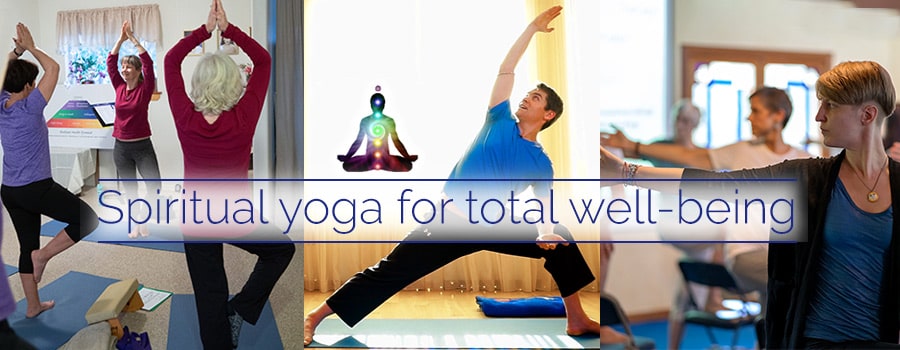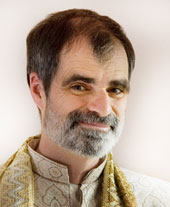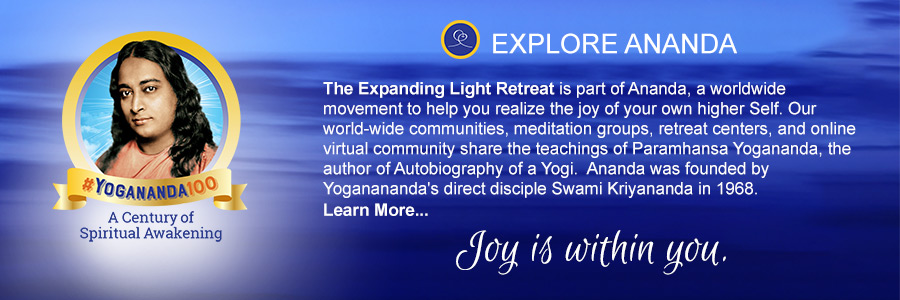Can You Teach Ananda Yoga® in a Fitness Center?
Ever since I began to teach Ananda Yoga®, I’d managed to stay away from fitness clubs. It seemed to me that Ananda Yoga would not be well received in these mainstream clubs.
However, all that changed last year when the Northwest Fitness Complex here in Portland contacted Ananda Portland in autumn 2003, asking for a yoga instructor.
I actually wasn’t too keen on getting the job, so in the interview I told them that I wasn’t interested in power yoga, or the so-called ashtanga yoga that isn’t Patanjali’s, or any other aerobic form of yoga.
I informed them that I teach a more gentle and inward style. But they were open to that, since their last yoga instructor had been too hard for most of their members to follow; she usually left students out of breath and exhausted. In addition, the Complex tends to draw an older crowd, and the manager felt they might welcome my style.
The interview was full of questions, but with my training and experience, I was hired the next day to teach two morning classes a week. Their previous yoga classes had been only an hour, which I felt was too short to include all the elements of a good class, so I insisted that the classes increase to 75 minutes. The managers consented — my first victory in the fitness club arena!
Reality Check
The Complex is pretty standard. As you walk in, you see several people on treadmills — they appear to be dying, but distracting themselves from their dire condition by watching TV or reading a book. The loud music playing just outside the yoga room is the same music played in most fitness clubs: it pounds the ever-present musical theme of, “Beat your body! Beat your body!”
The yoga room has nice wood floors, but the walls are surrounded with mirrors, weights, and chairs, with no wall space at all for asanas. Worst of all was the temperature: they keep it at 61 degrees because it is mainly used as an aerobics classroom, a practice that is typical for most health clubs.
I quickly saw that, even though the yoga students had been with the previous instructor for eight months, they had been given (or had absorbed) very little instruction on how to do any of the postures correctly. They had just been following along at her rapid pace — and since she said she was “teaching yoga,” they believed they were now accomplished yoga students. Not so!
I’m still not sure what they had been doing, but it appeared to have been some sort of aerobic movement. Some of the students had loved it and were wondering what style of yoga I was doing. I told them it was a classical style of yoga, and they said they once had an instructor who did yoga a bit like that. I wanted to tell them that their last teacher was not teaching yoga at all, but I decided to let them think it was just another style. (I’ve since learned that here is a high turnover in yoga instructors for fitness centers, and it tends to confuse students when they see so many different styles.)
All this meant that my first two classes had to be “back to basics.” Through these, I quickly gained the respect of my students for my knowledge of yoga. I could actually provide clear instructions on how to get into and out of each posture, with safety tips, etc. How novel! But even though they appreciated and benefited from that knowledge, they still wanted a challenging routine for their bodies. So in the third class, I led them through a difficult routine, just to let them know they could be challenged in this style.
After two weeks, I felt a bit frustrated. The studio was still cold. Some students still thought yoga was supposed to be aerobic. That awful, loud, pounding music was still playing. And I still had a difficult mix of students: seniors, stiff younger students, persons with strength but little flexibility, and a few overambitious students who wanted challenging postures regardless of whether they could safely get into and out of them. Not an easy group. I was beginning to wonder whether I could pull it off.
Then things began to change. After two weeks of trying everything I could think of to get management to turn up the heat, I finally got them to keep my classroom at 67 degrees. I was also able to get them lower the volume of the music in the main room during my classes. Two more substantial victories for my Ananda Yoga classes!
Going into my fourth class, I realized I needed to offer a way that they could see their evolution as yoga students. I needed an approach that was within the Ananda style, but also satisfied this diverse group whose primary goal was bodily conditioning. So for the next two classes, I began to establish a basic routine of yoga postures that would facilitate that. It’s a format that I still use.
As students arrive, I have blankets and ties at every station. I bring my own props, because as with most fitness clubs, this club has very few — just some 3/4" foam mats that give good padding for knees, but not much else. The Complex sells yoga mats, and most students bring their own.
I always start right on time — allowing latecomers to enter the classroom quietly — with listening to the breath and noticing where tension is in the body.
Then we do 2 – 3 simple pranayamas, followed by several easy and centering warm-ups with shoulders, upper body, and neck — all while seated cross-legged (or, for some, in a chair). We do the arm position of the eagle pose (often with a strap) and other simple stretches, an easy cross-legged twist, and a basic sideways stretch. We often do the Circle of Joy and a few Energization Exercises as well.
Finally we work with the neck and the jaw. The warm-ups are slow, inward, and focused. There are many, many warm-ups to choose from, so it’s not hard to keep them varied and interesting. [Editor’s note: See Nicole DeAvilla’s article, The Perfect Warm-Up.]
Of course, I have to adjust this routine to stay within the students’ ability to sit comfortably. Most students have no idea how to sit, so it’s very important to teach them how. Even then, if you keep them sitting for very long, it will not be enjoyable. I try to choose sitting warm-ups that can be done easily in a chair, so seniors and inflexible students can participate fully. Not everyone can sit cross-legged, but — wouldn’t you know it? — some students who should use chairs don’t want to use them.
In preparation for standing asanas, we increase the intensity with some standing warm-ups. For example, we do circles with one leg while balancing on the other leg. Or we extend each leg to the front, back, and side, then raise the knee and go into a tree pose as a warm-up (so that later when we do the softer version of the tree pose, they’ll be practiced and won’t be a bunch of swaying trees). I sometimes use a few classical asanas as warm-ups, too.
After a few energetic standing warm-ups. I begin a basic Ananda Yoga routine with standing poses. Since they have been worked out via the warm-ups, they are better able to relax and move more inwardly into the pose.
I often do a standard set of postures: Ardha Chandrasana, Padahastasana, Backward Bend, Vrikasana, Trikonasana, etc. (I don’t often use the Sanskrit asana names with these students.) Next, we do one round of Surya Namaskar — slowly and with a focus on alignment. I like this sequence because there are so many variations.
If you know how to present it, almost anyone can do it — yet there are also difficult variations to satisfy the Type-A’s.
(Speaking of variations, one thing that always amazes me is that, even though I give alternative ways to do a posture, every student — even the most unlimber and sickly of the bunch — wants to try the hardest way. It seems they feel that, if they’re not doing something heroic, they’re not really exercising. I don’t mind them trying, but I’m always alert to postures that might hurt them. Improper alignment of neck, spine, or knees is something that should not be overlooked; it must be corrected as soon as you see it.)
Next come the seated and floor postures: Janushirasana, Rajakapotasana, cat/cow, Balasana, Sasamgasana, etc. We don’t do “major” inversions like Sarvangasana, because there is no good wall space (wall-to-wall mirrors and prop storage) and there are too many levels of students. Besides, only one or two are flexible enough to do inversions safely, and I have too little time. I am sure that some of the inflexible over-achievers would throw their bodies up into positions that they shouldn’t be in at all. If I had better wall space, I could at least do legs-up-the-wall pose with pillows under the buttocks.
I know inversions are central to Ananda Yoga, but fitness centers make it a bit difficult. Anyway, no one has seemed to care. We end with a deep relaxation for about eight minutes.
Helping Fitness Students Understand the Core of the Practice
I vary the routine from class to class, but we always work on the alignment of the basic poses. I myself haven’t perfected any of them yet, so I know it takes time — and patience — for students to learn proper alignment. The reward, however, is that they go deeper into yoga practice. They begin to see the inward, and not just the outward, form of hatha yoga, and the power it has to transform their lives. I always use the asana affirmations. I find that students invariably appreciate them wherever I go.
Often students will ask for a list of the affirmations, so I make them available on my web site (www.yogaforjoy.com) — attributing them to Ananda Yoga, of course. [Editor’s note: Many Ananda Yoga teachers sell the flash cards to their students. AYTA members receive a discount on a purchase of six or more decks. Please contact Mary Weber at 800-346-5350 to order.]
I kept the pauses short at first because the concept was new to this group, but I never leave them out completely; they’re just too important to the overall practice. Most fitness students don’t understand the purpose of a pause; they think it’s a waste of time. They are Type-A and want to move. So to avoid losing them during the pauses, you have to keep them busy — if not physically, then mentally. For example, during the pause, I’ll remind them, “Put equal weight on both feet,” or “Breathe from the lower lungs,” or “Roll the shoulders back and down.”
Also, I have to be careful not to teach something that the students aren’t ready for; otherwise, it can cause a bit of trouble. For example, a fitness club class might not respond to an instruction to “feel the effect of the pose,” because many just aren’t able to feel it yet. I believe that the key is to guide them into what they should be observing during the pause.
After about twelve classes, they finally begin to enjoy the stillness between the postures. (Patience, I’ve found, is the key to teaching Ananda Yoga to this group.) The pauses become invaluable not only for helping students feel what’s happening inside and re-center themselves, but for avoiding injuries to older, inflexible bodies that may otherwise be trying to play catch-up with younger, more-athletic students.
Assisting Students — A Valuable Skill
Of course, adjusting students is an important aspect of being a good yoga teacher. But how to adjust them is always a question. For example, if a person is doing Adho Mukha Shvanasana incorrectly, it may be due to any of several factors: insufficient shoulder/arm strength, limited flexibility in the hips or shoulders, tight hamstrings, or simply lack of body awareness.
The Complex doesn’t use medical questionnaires, so like all yoga teachers, I must rely on my observation skills — and ask questions if necessary. As long as a student is not in a dangerous position, there’s no need to rush in and assist. Trying to bring a person physically deeper into a pose may do more harm than good.
Normally I sometimes model and sometimes adjust, but recently I had two non-yoga-related accidents that put me on crutches for quite a while. I couldn’t practice or even demonstrate poses for the students. But by using students as models and talking them through the asanas, I managed to miss only one week of classes. And as I concentrated on ways to adjust the students, they came to love the adjustments.
As in classes everywhere, many new students have no idea what their bodies are doing; they rely on the instructor to help them, and will feel neglected if left alone.
“I Rise Joyfully to Meet Each New Opportunity!”
One thing I have learned in this class is the need for strengthening postures. Often hatha yoga is considered to be merely a means for gaining flexibility. But flexibility without strength leads to a poor yoga practice — and quite possibly, to injuries.
I have been in classes where the challenge and strength of yoga is missing. And I’ve seen that fitness club students will not stay around long without it. Is Ananda Yoga challenging enough for a fitness club? Just take a half-hour class with Gyandev, and you will see it provides ample challenge.
If you provide them with a bit of challenge, they are more ready to relax and enjoy the postures. (Of course if you are going to provide the challenge, then you must keep up your own private practice to gain the strength yourself. For me, doing asanas, Energization Exercises, and walking provides all the strength training I need.)
I still have to choose my words somewhat carefully on occasion — for example, I know that I have a few fundamentalist Christians in my class. However, I have never heard of a complaint about anything I have said.
And although I don’t change the wording of affirmations, I am careful to explain them when necessary. Given a context for understanding them, students are much more receptive.
I must admit that I go out on the limb at times as I continue to teach the broader yoga principles behind hatha yoga. But I feel that we must teach what we are inspired to do, else we ourselves will lose touch with our own divine presence.
How are my classes doing? I added a Saturday class about eight months ago, and the staff and owners often attend my classes. I have a very good core of people coming to all of the classes. But the best part is that they are beginning to understand and appreciate the virtues of Ananda Yoga.
Related
All authors are graduates of Ananda Yoga Teacher Training.





















